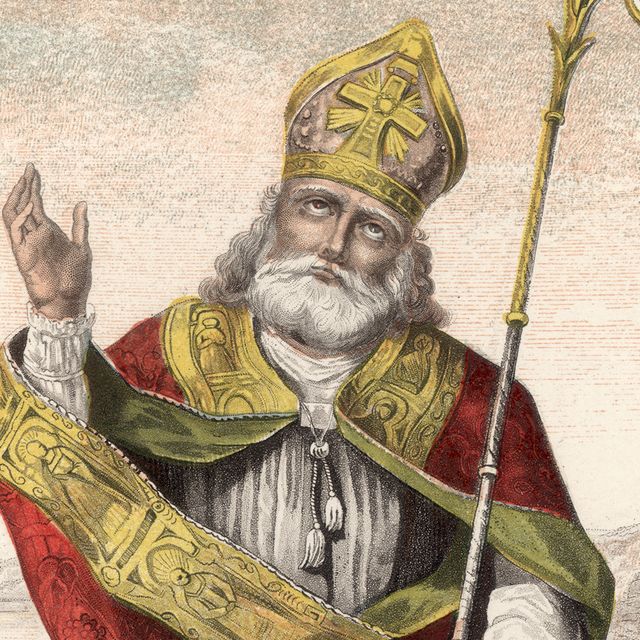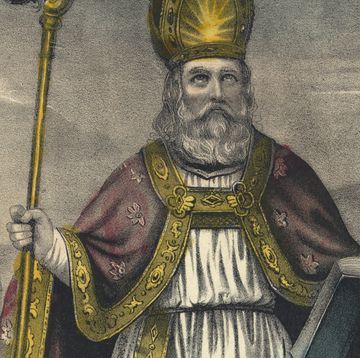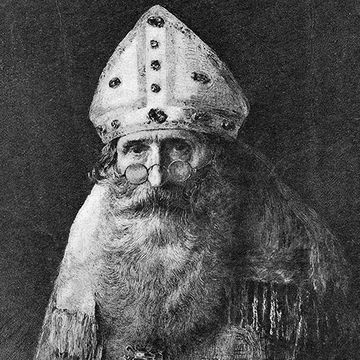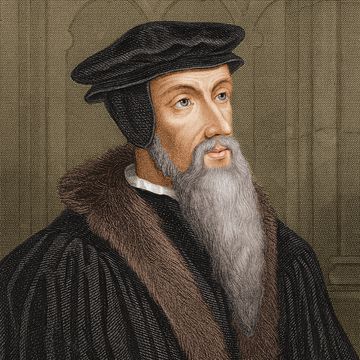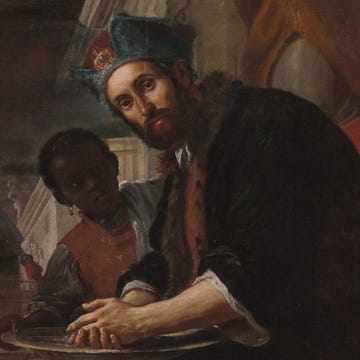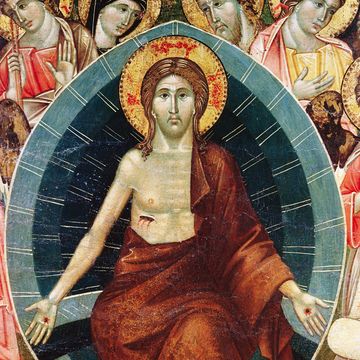386–461
Who Was Saint Patrick?
The man who would come to be known as Saint Patrick was a missionary that helped spread Christianity throughout Ireland during the 5th century. Much remains unknown about his life, including his birth name, but British-born Patrick became a devout Christian during his six-year enslavement in Ireland. He escaped only to return to Ireland later in life as a missionary, combining Irish pagan beliefs with Christian sacrament in his teachings. A religious figure within the Christian and Catholic faiths, he died around 461 AD and later became the patron saint of Ireland. Saint Patrick is annually honored throughout the world on his feast day, March 17.
Quick Facts
NAME: Saint Patrick
BORN: circa 386 AD
DIED: circa 461 AD
BIRTHPLACE: Britain
FEAST DAY: March 17
Early Life
Saint Patrick was born in Britain circa 386 AD. Much of his life is unknown to historians and can’t be verified, though some sources have listed his birth name as Maewyn Succat, with the name Patrick later taken on during his religious journeys or ordainment.
His father, Calphurnius, was a deacon from a Roman family of high social standing. Patrick’s mother, Conchessa, was a close relative of the great patron Saint Martin of Tours. Patrick’s grandfather, Pontius, was also a member of the clergy.
Surprisingly, Patrick was not raised with a strong emphasis on religion. Education was not particularly stressed during his childhood either. Later in life, this would become a source of embarrassment for the spiritual icon, who would write in his Confessio, “I blush and fear exceedingly to reveal my lack of education.”
Enslavement in Ireland
When Patrick was 16 years old, he was captured by Irish pirates. They brought him to Ireland, where he was sold into slavery in Dalriada. There, his job was to tend sheep. Patrick’s master, Milchu, was a high priest of Druidism, a pagan sect that held major religious influence over the country at the time.
Patrick came to view his enslavement as God’s test of his faith. During his six years of captivity, he became deeply devoted to Christianity through constant prayer. He saw the children of pagan Ireland reaching out their hands to him in a vision and grew increasingly determined to convert the Irish to Christianity.
Freedom and Religious Calling
Around 408 AD, the idea of escaping enslavement came to Patrick in a dream, in which a voice promised him he would find his way home to Britain. Eager to see the dream materialize, Patrick convinced some sailors to let him board their ship.
After three days of sailing, he and the crew abandoned the vessel in France and wandered, lost, for 28 days—covering 200 miles of territory in the process—with Patrick ultimately reuniting with his family.
A free man once again, Patrick went to Auxerre, France, where he studied and entered the priesthood under the guidance of the missionary Saint Germanus. He was ordained a deacon around 418 AD by the Bishop of Auxerre (likely Germanus, who became the bishop in 418 AD).
As time passed, he never lost sight of his vision to convert Ireland to Christianity. In 432 AD, he was ordained as a bishop, and soon, Pope Celestine I sent Patrick to Ireland to spread the gospel to non-believers and to support the small community of Christians already living there.
Missionary Work
Upon his arrival in Ireland, Patrick was initially met with resistance but managed to spread Christian teachings far and wide, along with other missionaries, through preaching, writing, and performing countless baptisms.
Recognizing the history of spiritual practices already in place, Patrick incorporated nature-oriented pagan rituals into church practices. It is believed that Patrick introduced the Celtic cross, which combined a native sun-worshiping symbology with that of the Christian cross.
Throughout his missionary work, Patrick supported church officials, created councils, founded monasteries, and organized Ireland into dioceses.
Death and Legacy
Saint Patrick died circa 461 AD in Saul, Ireland, and is said to have been buried in the nearby town of Downpatrick, County Down. Saint Patrick is recognized as the patron saint of Ireland, and his writings, noted for their humble voice, include the autobiographical Confessio and Letter to Coroticus.
Many legends have been associated with his life, including that he drove away all the snakes from Ireland and that he introduced the Holy Trinity through the three-leaved shamrock. In fact, snakes have long been absent from Ireland’s natural ecosystem because of the climate and possibly the island’s watery surroundings. Saint Patrick’s reptilian banishment, then, is just the stuff of folklore. As for the Holy Trinity, there’s no definitive proof regarding how Saint Patrick taught it.
Perhaps his greatest legacy is Saint Patrick’s Day, an annual feast to honor Saint Patrick. The celebration occurs on March 17, which some cite as the date of his death, during the Christian season of Lent.
Canonization and Sainthood
While Patrick is the patron saint of Ireland, he was never officially canonized by the Catholic church. There was no formal canonization process during the first millennium, so many saints from that time received the title by popular acclaim if they were martyrs or seen as extraordinarily holy.
Various Christian churches also declare that Patrick is a saint in heaven.
Saint Patrick’s Day
For more than 1,000 years, the Irish have observed Saint Patrick’s Day as a religious holiday. Traditionally, on Saint Patrick’s Day, families attend church in the morning and observe other rituals, including eating a traditional meal of cabbage and Irish bacon. More recently, Dublin has hosted a days-long festival that features live music, pageantry, dancing, street theater, and Irish language activities. A parade highlights the celebration on March 17.
Over the years, the Saint Patrick’s Day holiday has become a robust international celebration of Irish culture and heritage. The first recorded parade in honor of Saint Patrick’s Day took place in 1601 in a Spanish colony in what is now Saint Augustine, Florida. Under the direction of the colony’s Irish vicar, marchers likely carried an image of the saint and celebrated with food, drink, and music. Similarly, early Irish settlers, many of whom were indentured servants, brought the annual celebration to the American colonies.
Boston first celebrated Saint Patrick’s Day in 1737 as a gesture of solidarity among the city’s Irish immigrants. In 1901, its parade moved to South Boston and became a dual celebration also commemorating Evacuation Day, when residents forced the evacuation of British troops from the city in 1776.
The New York City Saint Patrick’s Day Parade claims to be the largest in the world, with the first held 14 years before the signing of the Declaration of Independence in 1762. Approximately 150,000 marchers take part in the event, which draws around 2 million spectators.
Chicago’s Irish parade was first held in 1843 and became an official city event during the 1950s. The parade lasts about three hours, winding up Columbus Drive and through Grant Park. Additionally, the city’s plumbers union uses environmentally friendly dye to temporarily turn the Chicago River green, a tradition that started in 1962.
Montreal has celebrated Saint Patrick’s Day with an annual parade since 1824, making it one of the oldest.
Saint Patrick’s Cathedrals
There are two notable cathedrals bearing Saint Patrick’s name: one in Dublin and the other in New York City.
The Dublin cathedral serves as the National Cathedral of the Church of Ireland and is the largest in the country. It was built between 1220 and 1260 and is one of the city’s most popular tourist attractions. Jonathan Swift, the author of Gulliver’s Travels, served as dean in the 1700s and is buried on site. The cathedral choir, established in 1432, still performs daily during school term.
Saint Patrick’s Cathedral in New York City is also one of the most famous places of worship in the world, with nearly 5 million visitors each year. Twenty-one years after its cornerstone was laid, the Gothic-style cathedral officially opened on May 25, 1879. Thousands of immigrants, as well as 103 prominent citizens who each pledged $1,000, funded the cathedral’s construction. The building has 94 stained glass windows and features a Lady Chapel dedicated to the Blessed Virgin Mary and a crypt where several former city archbishops are laid to rest.
Cardinal Eugenio Pacelli, who would become Pope Pius XII, presided at the 26th anniversary of the cathedral’s consecration in 1936. Pope Benedict XVI celebrated a mass at the cathedral on April 19, 2008.
Quotes
- If I have any worth, it is to live my life for God so as to teach these peoples, even though some of them still look down on me.
- I am certain in my heart that all that I am, I have received from God.
- I am at a loss to know whether to weep more for those they killed or those that are captured, or indeed for these men themselves whom the devil has taken fast for his slaves.
- I am imperfect in many things, nevertheless I want my brethren and kinsfolk to know my nature so that they may be able to perceive my soul’s desire.
- Before I was humiliated, I was like a stone lying in the deep mire.
- I am Patrick, a sinner, most unlearned, the least of all the faithful, and utterly despised by many.
- The Lord opened the sense of my unbelief that I might at last remember my sins and be converted with all my heart.
- It is honorable to reveal and confess the works of God.
- By the tongue will be discovered the wise man, and understanding, and knowledge, and the teaching of truth.
- We ought to fish well and diligently.
- I blush and fear exceedingly to reveal my lack of education.
Citation Information
- Article Title: Saint Patrick Biography
- Author: Biography.com Editors
- Website Name: The Biography.com website
- URL: https://www.biography.com/religious-figures/saint-patrick
- Access Date:
- Publisher: A&E; Television Networks
- Last Updated: March 14, 2023
Fact Check: We strive for accuracy and fairness. If you see something that doesn't look right, contact us!..
